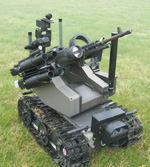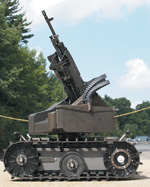Combat Robot Ready for Limelight
 |
The modular advanced armed robotic system (MAARS) robot is designed to support troops in combat situations. Equipped with a 7.62-millimeter machine gun and four 40-millimeter grenade launchers in a rotating turret, the robot can directly engage enemy forces. MAARS is also equipped with thermal and video sensors, sensitive microphones and speakers to communicate with civilians and other troops. The robot is currently being evaluated by the U.S. Army, U.S. Marine Corps, Special Operations Command and the National Guard. |
An armed ground robot with its own sensors and weapons is undergoing operational trials with
Use of unmanned ground vehicles (UGVs) has skyrocketed since
The modular advanced armed robotic system (MAARS) was engineered for combat from the beginning, explains Charles E. Dean, program manager for advanced robotics at Foster-Miller Incorporated,
Although it is still in the advanced prototype stage, MAARS is in limited rate production for U.S. Special Operations Command (SOCOM). The Army,
Unlike SWORDS, which was a Talon explosives-ordnance-disposal UGV modified to carry a machine gun, Foster-Miller engineers designed MAARS to carry out a variety of missions, including armed combat. Dean maintains that MAARS would not exist without SWORDS. Testing and fielding SWORDS and experiencing its shortcomings allowed the company’s engineers to create an entirely new system. Without this background, it is possible that “we might be designing SWORDS today,” he admits.
Dean says that SWORDS was a watershed robot that allowed both the Army and Foster-Miller to learn about developing and operating armed UGVs. He explains that company designers assessed all of SWORDS’ strengths and the improvements requested by the customer and combined them in the design of MAARS, while avoiding its predecessor’s shortcomings. SWORDS had a number of balance-related operational weaknesses. The machine gun raised the robot’s center of gravity, increasing the possibility of the UGV tipping over on uneven terrain if it was not driven carefully. MAARS is three inches wider and four inches longer than the Talon, and has a lower center of gravity. It is also heavier: A fully armed MAARS robot weighs 350 pounds with a combat load of 450 rounds of 7.62-millimeter machine gun ammunition and four 40-millimeter grenade rounds.
Dean notes that the robot can be set to escalate the use of force from nonlethal to lethal operations. It also provides an unmanned reconnaissance capability with its cameras, thermal imaging system and microphones. MAARS operators can talk to troops and civilians through speakers mounted on the vehicle.
The robot’s machine gun can be depressed to point at the ground when around civilians. The weapon can also be elevated to 60 degrees, allowing it to fire at the upper floors of buildings in confined urban areas. Another important feature is that the machine gun is mounted in a turret capable of 360-degree rotation. SWORDS could not rotate its weapon more than 20 degrees from its front because of the high center of gravity. This flexibility allows troops to make the machine less menacing by either depressing the weapon or turning the turret to face the gun away from people.
Army units used MAARS for day and night operations during a series of experiments at
Because it is electrically powered, MAARS does not have a large heat signature, which makes it very difficult to spot with night vision equipment. Dean notes that in the experiment, troops playing opposing forces had infrared night vision goggles but no thermal imagers.
The robot’s small size allowed it to be easily concealed. Units camouflaged their MAARS systems with the ghillie material commonly used to conceal human snipers. The robot was very difficult to see in a tree line or in tall grass. MAARS is not armored and relies on its small size for protection. Dean notes that the robot can be armored, but the increased weight slows the machine down and increases battery drain. “It gets its protection from being little and fast,” he says.
However a key operational challenge is understanding how armed robots work at the platoon and squad level, says Lt. Col. Matt England,
A related issue is what happens if a robot is disabled. The robot’s machine gun cannot be left in the field where the enemy can recover it. These philosophical and practical operational issues must be addressed he says, adding that the Army will not deploy any armed ground robots until it has determined that they are safe to operate.
Foster-Miller is also working on a wearable control unit for MAARS. Dean explains that the main goal is to allow dismounted soldiers to control the robots in the field easily. He adds that it is important that the controller be light and intuitive enough to operate without impairing the combat effectiveness of the soldier using it.
 |
Although it is designed for combat operations, MAARS can perform a variety of missions. The gun turret can be quickly removed and replaced with a manipulator arm. A heavier, more robust version of the Talon robot, a manipulator-equipped MAARS can drag an object—such as a wounded soldier—weighing up to 200 pounds. |
MAARS can be commanded by a voice control technology based on the Speech Processing Earpiece (SPEAR) technology developed by Think-A-Move Limited,
Foster-Miller is also working on air-to-ground coordination between troops using MAARS and airborne platforms. Dean says that the robot is the first UGV to have an integrated one-system remote video terminal capability that allows ground forces to view video from UAVs. Soldiers can choose video channels from specific unmanned platforms, ranging from small tactical Raven UAVs to theater assets such as Global Hawks. Foster-Miller has embedded this capability in the controller to allow MAARS operators to access aerial reconnaissance data for increased situational awareness.
The colonel cautions that the testing at
Soldiers’ feedback has been positive, but the results only whet his appetite for more rigorous measurements, the colonel explains. Troops liked some of MAARS’ characteristics, such as the ability of the machine gun turret to turn quickly and bear on targets. He notes that the robot was effective in applying direct fire, although it has not yet participated in any live fire exercises.
Troops found MAARS’ speed sufficient to keep up with troops during operations; however, they said they wanted the robot to have a sprint capability—short, rapid acceleration to cross gaps or to move when under fire. The colonel contends that MAARS is better than SWORDS in capability and utility and claims that it is currently the best armed robot available in its category. “MAARS is not your granddaddy’s robot,” he says.
Soldiers also identified some of MAARS’ limitations. At 350 pounds, the robot is heavy and has limited mobility in difficult terrain. Another shortcoming is that the robot requires transportation for long-distance travel. In the experiment, the robot was transported by a prime-mover platform based on the Polaris MVRS 700 utility vehicle, which was modified with a ramp to deploy the UGV, ammunition storage and battery recharging capabilities. A robot control unit and a mount for a large controller are located on the vehicle’s dashboard. “It’s fine to drive the robot around for immediate operations. But if you have to move 10 kilometers, you don’t want to have to always walk it,” Dean says.
MAARS is not currently under a program of record. Dean notes that there is no assigned program manager because there is no immediate funding to support embedding MAARS into active units. Col. England maintains that momentum exists in the Army for the development and use of armed ground robots. If MAARS performs well in the utility assessment, the next step will be an overseas operational assessment under real combat conditions. Success here would lead to a program of record. However, the colonel cautions that until these steps are taken, writing an operational requirement would be premature. MAARS must first prove itself in the field, and this success must generate enough interest among Army leaders to launch an acquisition program.
The next opportunity for a utility assessment will rely on a unit’s availability and funding. Col. England explains that this complication is not because of a lack of interest by the Army, but he adds that the timeline is unpredictable. If funding is found, it may be between one to six months before a unit is available because of operational rotation issues.
WEB RESOURCES
Special Operations Command: www.socom.mil
Foster-Miller: www.foster-miller.com
Think-A-Move Limited: www.think-a-move.com




Comments